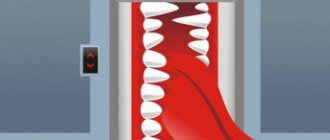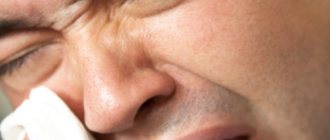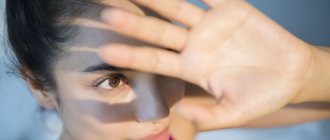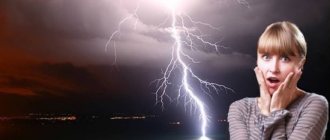A panic attack, also called episodic paroxysmal anxiety, is a special type of anxiety disorder that usually occurs due to stress. They happen suddenly and are accompanied by intense fear, increased heart rate, trembling, shortness of breath, increased sweating and a feeling that something terrible is about to happen. This condition is very difficult for a person to tolerate and in 70% of cases is complicated by depressive states and the occurrence of suicidal thoughts.
Basic information and theories of origin
A panic attack can last from a few minutes to an hour. But most often it lasts no more than half an hour and goes away as abruptly as it appeared. And although it does not pose a serious threat to physical health, such attacks of severe fear are very exhausting and damage a person’s mental state. In addition, having once suffered such an attack, people are unconsciously afraid of its repetition and are constantly in a state of stress, which further aggravates the situation. In the future, panic attacks can lead to:
- avoiding crowded places and limiting movement;
- fear of being alone;
- fear of being far from home or in a place where it is impossible to quickly receive qualified medical care;
- severe depressive states;
- disturbances in concentration;
- loss of performance.
Today, panic attacks are not uncommon among either women or men. Although women are 5 times more likely to suffer from them than men. According to statistics, about 10-20% of people around the world experience a panic attack at least once in their lives. In other words, almost every fifth person experienced an attack of severe fear at least once. Therefore, many experts already consider panic attacks not even as a disorder, but as a feature of human behavior.
At the same time, about 0.5-1% of people regularly experience panic attacks. But this is an average. It varies greatly depending on a person's region of residence, country, social conditions and other factors. In such situations, they already speak of the presence of pathology, and in 2/3 of all cases, neurological or mental disorders are detected. And 20% of people from this number have alcohol or drug addiction.
Most often, panic attacks are observed in women and men aged 25-45 years. Although they can also occur in older people and adolescents. It has been noted that they are more typical for people with an above average level of intelligence.
Panic attacks can occur on their own or develop against the background of other diseases, not only mental, but also pathologies of the cardiovascular, endocrine system and others. Sigmund Freud once attempted to describe panic attacks by calling them anxiety attacks. Subsequently, they were considered as a manifestation of vegetative-vascular dystonia and were called an emotional-vegetative crisis.
A large amount of work has been done on the study of anxiety states, and only in 1980 the term “panic attack” was introduced, including in ICD-10, to describe the main manifestation of such disorders. But research in this area and anxiety disorders developing against the background of panic attacks is still ongoing. The result of this was the creation of a number of theories of the occurrence of panic attacks, although today many experts are inclined to believe that a panic attack is a consequence of a combination of various factors described in individual theories.
It has been precisely established that the primary source of their development is the physiological processes occurring in the body as a result of stress, namely changes in the functioning of the temporal lobes of the brain and some parts of the limbic system (a set of brain structures located on the sides of the thalamus). As a result of anxious thoughts, adrenaline is released, which aggravates anxiety. This in turn can trigger a panic attack, which increases anxiety. This creates a vicious circle that can be difficult to break.
Catecholamine theory
This hypothesis is based on the possibility of a panic attack occurring against the background of an increase in the level of catecholamines, which include adrenaline. They are produced by the adrenal cortex in response to stress factors. These compounds have stimulant properties, meaning they cause blood vessels to constrict, which leads to increased blood pressure levels, and also stimulate the nervous system and lead to an increase in heart rate.
Genetic theory
This theory is based on the fact that 15-20% of people suffering from panic attacks have relatives with the same anxiety disorders.
Psychoanalytic theory
This hypothesis was developed by S. Freud and has since been refined by other researchers. According to it, panic attacks occur against the background of a lack of emotional, including sexual, release, and the presence of a person’s conflict with himself and his needs. This leads to physical tension. Over time, a conflict or other stressful situation provokes the development of anxiety.
Behavioral theory
This theory is based on the connection between a panic attack and external causes, which can be situations that threaten a person in one way or another. The resulting increase in heart rate is recorded by the body as a trigger. And subsequently, when the pulse rate increases, which may be a symptom of one or another heart pathology, a panic attack develops even in the absence of a threat.
This theory also describes cases of the development of anxiety states in people prone to pessimism. For example, one day, while in transport, a person is struck by the thought that an accident might happen. If it causes fear, a panic attack may develop even against the background of complete well-being and no danger to life. In such cases, a panic attack is not a consequence of a direct threat, but of a far-fetched potential situation.
Cognitive theory
This theory is based on a person’s ability to misinterpret their feelings. Thus, shortness of breath after exercise or increased heart rate may be mistakenly perceived as life-threatening. The result is fear and a panic attack.
Why does a panic attack occur?
A panic attack has real or fictitious causes. Real ones, as a rule, are associated with experiences and mental disorders. If a person has been subjected to severe stress, he may experience panic fears. Unlike true ones, fictitious reasons may be associated with some kind of internal fear.
Sometimes panic may occur in a person who is in the subway or other crowded place. Attacks of this type occur spontaneously, they are characterized not only by panic, but also by physiological symptoms. In any case, you need to fight panic. Untimely or illiterate treatment leads to chronic disorders. Serious illnesses arise against the background of such disorders.
Mental disorders associated with panic attacks are treated by a psychotherapist. If the treatment is successful, the alarming symptoms disappear and will not bother you in the future. You need to overcome a panic attack on your own. You need to regain control over the activities of your own psyche. Not only psychotherapy helps in the fight against mental disorders; breathing exercises and moderate physical activity are also effective. Various methods are used in treatment, the purpose of their influence is to calm the patient and inspire him that attacks of fear are not life-threatening.
Fight panic using different methods! You should lead a healthy lifestyle and give up all bad habits. It is important to avoid stress: they are the main predisposing factors to such disorders.
Causes
Most often, panic attacks are considered as mental disorders, but they can occur in people with a sensitive psyche when suffering from an illness, especially a severe one, before an upcoming surgical intervention, during an economic crisis, etc.
Therefore, the following reasons for the development of panic attacks in women and men are identified:
- Heart diseases, in particular angina pectoris, coronary artery disease, mitral valve prolapse, myocardial infarction, and bronchial asthma can cause a feeling of depression and danger to life. This is aggravated by the occurrence of symptoms characteristic of these diseases, especially shortness of breath, increased heart rate, and discomfort of varying degrees of intensity in the chest area. As a result, anxiety may develop, but in such situations it is the physical signs of a panic attack that come to the fore, while the psychological ones (feelings of fear, anxiety) are usually moderately expressed.
- Gastrointestinal pathologies, including gastric ulcers and especially irritable bowel syndrome.
- Endocrine disorders, especially thyrotoxicosis and pheochromocytoma, can imitate conditions characteristic of panic attacks due to the development of a vegetative crisis, but in reality they are not.
- Physiological changes caused by changes in hormonal levels or the passage of certain life stages: the beginning of menstruation in girls, initiation of sexual relations, pregnancy, childbirth, menopause, etc.
- Taking certain medications, in particular drugs based on cholecystokinin, as well as drugs that activate the production of this hormone in the body, glucocorticosteroids and bemegride. Basically, such drugs are used to treat neurological diseases, severe inflammatory processes, withdrawal syndromes and mental disorders.
- Mental problems and disorders, including severe shocks (death of a loved one, divorce, dismissal), depression, schizophrenia, post-traumatic stress disorder, obsessive-compulsive disorder. People who have various phobias often suffer from panic attacks, including those who are afraid of society, heights, closed spaces, the dark, and diseases. In such situations, panic attacks are more manifested by emotional disturbances, especially causeless, severe fear and anxiety. In this case, physical manifestations are expressed moderately or even weakly.
It is important to distinguish a phobia from a panic attack, although in both cases we are talking about a neurotic disorder and stress. But in the first case, fear arises in direct connection with a causal factor (darkness, closed space, height, etc.), and a panic attack can occur in isolation without any clear reason. But sooner or later, phobias almost always lead to panic attacks.
However, the causes of panic attacks may also lie in the influence of social factors. Thus, a large number of researchers have come to the conclusion that a large role in the development of anxiety disorders is played by a large information load, a very fast pace of life and constant stress. This point of view is supported by the fact that residents of cities, especially megacities in highly developed countries, suffer from panic attacks tens of times more often than residents of rural areas.
It is the influence of society that largely explains the cases of panic attacks in children and adolescents. They are often observed in especially emotionally labile children before competitions, competitions, exams, etc. But this does not exclude the possibility that somatic factors, especially bronchial asthma, which has recently been increasingly diagnosed in children, are involved in the development of anxiety attacks. In such situations, the risk of exacerbation of bronchial obstruction increases against the background of severe anxiety.
Often children, and subsequently adults, who have suffered sexual abuse at an early age are susceptible to panic attacks.
Not the least important factor in the occurrence of panic attacks is the general level of stress resistance of a person. It is known that certain factors can reduce it, which creates the preconditions for the occurrence of an anxiety disorder. These include:
- the presence of bad habits, in particular abuse of caffeine-containing drinks, smoking, alcohol and/or drug use;
- maintaining a sedentary lifestyle;
- suppression of emotions, accumulation of grievances, presence of internal conflicts;
- sleep disorders.
20-30% of people taking cannabinoids experience panic attacks. This is one of the most common side effects of smoking marijuana.
Predisposing factors
The causes of panic disorders are not fully understood. There are many predisposing factors:
- Mental disorders may be related to genetics. If a close relative had mental illnesses, their hereditary transmission is possible.
- Acquired reasons include improper upbringing, for example, increased demands on the child from the parents.
- The reason may be tense family relationships.
- A predisposing factor is frequent quarrels with peers.
- Overly sentimental and sensitive people are more prone to this kind of disorder. If a person dwells on a specific situation for a long time and cannot abstract himself, he is more susceptible to mental disorders, including panic attacks.
- An attack may occur against the backdrop of a significant event that has left a negative imprint (the loss of a close relative, a natural disaster).
- Psychological disorders occur after operations or infectious diseases.
- A possible cause of the disease is fear of neurasthenia.
- Panic attacks often occur with vegetative-vascular dystonia.
Symptoms
The main difference between a panic attack and any other type of anxiety disorder is its sudden and irrational occurrence. This can happen in any circumstances. But subsequently there is a fear of their development in those places or in those situations in which episodes of panic have previously occurred. As a result, a person begins to avoid getting into such circumstances, which can become frightening. In some cases, people lock themselves at home and even refuse to eat, fearing a second attack.
Panic attacks can occur with varying frequencies from once a week to once every 6 months.
The manifestations of a panic attack are quite varied. But all of them can be divided into mental and physical. Panic sets in abruptly, with mental symptoms initially appearing. Patients say that in such situations, dozens of frightening thoughts instantly appear in their heads, they get confused, and after just a few minutes they often cannot even accurately describe what caused the fear. At such moments there are:
- anxiety;
- a feeling of irresistibly impending danger;
- fear of death, madness;
- feeling of a lump in the throat;
- inability to focus on one object;
- a feeling of unreality of what is happening.
This can lead to a strong desire to run and hide or, on the contrary, drive the patient into stupor. This is accompanied by the manifestation of physical symptoms, which are more pronounced in the presence of abnormalities in the functioning of internal organs:
- increased heart rate;
- trembling in hands;
- pallor;
- hot or cold flashes, especially in the face and neck;
- discomfort, tightness, or pain in the chest;
- dry mouth;
- numbness or tingling sensation in the arms and legs;
- sweating;
- increased breathing (shortness of breath), feeling of suffocation;
- abdominal discomfort caused by reflex indigestion and diarrhea;
- weakness, dizziness.
At the same time, all the symptoms quickly, like an avalanche, gain intensity and within a few minutes completely capture the person’s consciousness. If more than 4 symptoms are present, a panic attack is considered to be a full-blown panic attack; otherwise, it is said to be a minor or abortive attack. At the same time, the same person often alternates between large and small anxiety attacks.
Panic attacks can happen both during the day and at night. Moreover, it has been noted that night attacks are most typical for strong-willed people who know how to control their emotions during the day. And since self-control disappears at night, suppressed fears and worries manifest themselves in the form of a sudden attack of anxiety.
The severity of symptoms increases with emotional or physical stress, against the background of fatigue, especially with chronic lack of sleep, use of psychostimulants, coffee, and alcohol. On the contrary, high-quality, complete rest and emotional calm lead to easier attacks.
Thus, panic attacks directly do not pose a serious threat to a person’s life, but they sharply reduce its quality and can even lead to loss of performance and isolation. Therefore, it is important to consult a doctor if you experience attacks of fear and anxiety, especially in combination with the other symptoms described above.
Clinical picture
Manifestations of panic are different. Symptoms of a mental disorder may resemble a heart attack. It is worth noting that due to frequent fears and panic attacks, the functioning of the central nervous system is disrupted. A disorder accompanied by fear is characterized by a feeling of internal tension.
Such a state can be expressed as follows:
- Tachycardia and shortness of breath occur.
- Chills appear and the body may feel hot.
- Manifestations of the disease include tremors of the limbs.
- Due to impaired breathing function, suffocation is observed.
- Heart pain may occur.
- Attacks lead to diarrhea or constipation.
- Some patients experience abdominal pain.
- Possible urinary incontinence and frequent urination.
- A symptom of a panic attack is fainting, which occurs in severe cases.
- The condition is characterized by surges in blood pressure.
The symptoms of this disorder should not be ignored! A panic state leads to psychological disorders. A person gets lost in space and does not recognize friends or relatives.
One of the manifestations of the disease is depersonalization. This means that the patient does not want to be aware of what is happening to him. He tries to abstract himself from the attack, but his attempts are unsuccessful. Panic is accompanied by disorientation, in which the patient does not recognize his home or the houses around him. Some people experience fear of schizophrenia.
Diagnostics
If signs characteristic of panic attacks appear, you should contact a neurologist, psychologist or psychiatrist. Diagnosis begins with establishing the number of episodes of panic fear. A person is said to be susceptible to panic attacks if there are several such cases that arise spontaneously without the presence of a real threat to life and health, as well as outside the use of drugs or medications.
To develop the most effective treatment tactics, it is also important to establish the type of panic attacks. There are:
- expected (situationally related and situationally predisposed) – when anxiety attacks are associated with the presence of a specific fear, for example, heights;
- unexpected – when there is no obvious reason for the occurrence of fear and a clearly traceable trigger, so it is impossible to predict in advance the possibility of its occurrence.
In the first case, panic attacks are largely a consequence of the presence of one or another phobia, obsessive-compulsive disorder, post-traumatic disorder, or depression. Therefore, in these cases they are secondary, and therefore treatment will be aimed primarily at eliminating the cause of their occurrence.
Sometimes an additional consultation with a cardiologist, gastroenterologist, endocrinologist or pulmonologist may be required to detect disorders in the cardiovascular, endocrine, respiratory or digestive systems. In such situations, a fairly wide range of studies may be required to exclude underlying diseases, including:
- ECG;
- daily monitoring of ECG and blood pressure;
- Ultrasound of the heart, abdominal organs;
- X-rays of light;
- determination of the level of basic hormones;
- EEG;
- X-ray or MRI of the cervical spine;
- Doppler ultrasound of cerebral vessels.
Therefore, panic disorders, as the main diagnosis, are spoken of only in cases of sudden onset of severe anxiety with the development of physical symptoms to a greater or lesser extent. It is important that there is no anxiety during the period between attacks.
It is also necessary to establish the severity of the patient’s condition at the time of the attack using tests aimed at detecting fears and a special scale. The Spielberg scale is often used for this purpose. To do this, he is asked to fill out a special questionnaire or orally answer the doctor’s questions. In addition, it is important for the doctor to observe the patient over a certain period of time, and also to obtain information about when and what diseases he suffered, how often he is exposed to stress and how much he is exposed to it, what changes have occurred in his life, etc.
Prevention
Understanding what panic fears are and what they mean means a lot when choosing methods to overcome them. Preventive measures include the following steps:
- identification of factors that are prerequisites for the occurrence;
- maintaining a healthy lifestyle (healthy lifestyle);
- increasing stress resistance;
- doing what you love.
A preventive action plan is developed by a psychotherapist exclusively individually for each person.
Appointment with a psychotherapist
Attention! Therapeutic measures include a course of psychotherapy and medication.
First aid for a panic attack
Since anxiety attacks occur spontaneously, it is important for loved ones and the patient himself to understand how to alleviate a panic attack. In such situations you should:
- Provide emotional support, trying to convince the patient not only that the situation will not harm him, but also that you will be there at all times. It is important not to be afraid yourself and to remain as calm and collected as possible.
- Resort to physical therapy methods to help the patient restore normal frequency and depth of breathing. By standing opposite him and demonstrating deep and unhurried breathing by your own example, you need to ensure that the patient repeats these actions. You can also use a paper bag, and if you don’t have one, use cupped palms that are pressed tightly against the patient’s face. Sometimes diaphragmatic breathing or belly breathing is more effective. But you need to make sure that you inhale through your nose and exhale through your mouth.
- Use a massage of the neck, shoulders, ears, bases of the thumbs and little fingers. This has a relaxing effect on muscles tense due to anxiety and helps to get out of a panic state.
- Try to distract the patient by counting syllables in different words, the number of buttons, windows in the house opposite with lights on, the number of parked cars, performing mathematical operations, etc. You can also try to distract yourself by playing games or singing songs. Sometimes pinching the patient is more effective, since pain helps to draw attention from disturbing thoughts to physical discomfort.
- Use medications prescribed by your doctor or call an ambulance. At the same time, it is important not to hesitate to seek qualified medical help, since the manifestations of a panic attack have much in common with myocardial infarction and it is not always possible to distinguish them independently, especially in older people.
Since each person experiences panic attacks differently, it will take effort to find exactly the one or those methods of help that will most contribute to calming and ending the attack.
If the attack does not stop, emergency doctors who arrive on the scene use tranquilizers or anxiolytics in the form of tablets or injections. They can also be taken independently, but only in cases where the attending physician allows it. Drugs in this group include:
- diazepam, which has a strong calming effect and a slightly less pronounced anti-anxiety effect;
- midazolam, which has anti-panic and hypnotic properties;
- temazepam, which produces a strong sedative effect and relieves tension.
These drugs are considered emergency medications and are used only to relieve severe panic attacks, since they lead to the development of addiction and can cause side effects of varying nature and severity. They give results 10-15 minutes after administration, but at the same time cause drowsiness, disrupt concentration, which prevents the patient from performing his daily duties, driving, or doing work in the near future.
What is panic fear (PS)
Psychotherapists define such emotional well-being. According to experts, panic is a feeling of anxiety, along with confusion and panic. It can be both individual and mass. Under the influence of panic, people can commit actions whose meaning cannot be explained from a logical point of view.
By the way! During a panic attack, a person loses the remnants of common sense, this prevents him from finding a way out of a difficult situation.
Panic fear, origin of the name
Treatment of panic attacks in women and men
Treatment of panic disorders usually requires the help of specialists in two fields: a neurologist and a psychologist or psychotherapist. This is due to the fact that complex therapy, including medication and psychotherapeutic treatment, is most effective. The use of only psychotherapeutic methods can be recommended exclusively for mild attacks occurring with a moderate level of anxiety. But drug treatment is basic. Since panic disorders dramatically increase the likelihood of suicidal behavior, refusal of drug therapy can lead to tragic consequences. Therefore, today an integrated approach is used to treat panic attacks in men and women, including psychotherapy and drug correction.
To control the patient’s condition and reduce the risk of developing repeated anxiety attacks, various drugs are used, the choice of which is carried out on an individual basis. These include:
- tricyclic antidepressants;
- MAO inhibitors;
- serotonin reuptake inhibitors;
- β-blockers;
- combination antidepressants;
- nootropics.
Sometimes anxiolytics or tranquilizers are prescribed, both to relieve panic attacks directly and for long-term use to eliminate the likelihood of developing new episodes.
As for psychotherapy, it should never be neglected in the treatment of panic disorders. It is no less important than drug treatment, and in the same way is selected strictly individually by the attending physician based on the medical history and characteristics of the patient.
As part of psychotherapy, people suffering from panic attacks may be offered:
- cognitive behavioral therapy;
- psychoanalysis;
- hypnosis;
- systemic family psychotherapy;
- NLP;
- Gestalt therapy;
- body-oriented psychotherapy.
You should not be afraid of psychotherapy and consider working with a psychologist or psychiatrist to be unimportant or beneath your dignity. It is an important element in the fight against panic attacks and helps reduce anxiety, overcome the effects of stress, chronic fatigue, internal conflicts and get rid of accumulated grievances.
Cognitive behavioral therapy is the type of psychotherapy used most often to treat panic disorders. It includes a number of successive stages with the goal of making the necessary adjustments to the patient’s thinking and attitude towards anxiety. Initially, the doctor will explain the pattern of development of a panic attack and help the patient understand how it occurs and what mechanisms are involved. This will help you get your anxiety under control and get rid of the fear of going crazy or dying during a panic attack from a heart attack or other cause.
Cognitive behavioral psychotherapy involves:
- keeping a self-observation diary;
- meditation practice;
- application of muscle relaxation techniques;
- use of breathing practices;
- detection of factors leading to increased anxiety and carrying out work to eliminate them.
The course of treatment usually consists of 8-20 sessions.
Other methods, in particular psychoanalysis, are used much less frequently in the fight against panic disorders. It is mainly used in the development of anxiety due to the action of specific traumatic factors. At the same time, hypnosis, as a method of treating panic attacks, can give good results in the short term, but it is not suitable for all patients.
It is imperative to minimize the amount of stimulants, i.e. give up or at least significantly reduce the amount of coffee, tea consumed daily, quit smoking, etc.
Tricyclic antidepressants
These are one of the first antidepressants to appear on the pharmaceutical market. They are indicated for patients who have suicidal thoughts, but cannot be used in severe cardiovascular disorders and in elderly patients.
When choosing drugs from this group, it is important to strictly follow the doses recommended by the doctor and increase them to the optimal dose in strict accordance with the developed regimen. In this case, after 2-3 weeks, tricyclic antidepressants will give the expected therapeutic effect and will lead to the complete elimination of panic attacks no later than 4 weeks after the start of treatment.
Their cancellation is also carried out only as prescribed by the attending physician, but even in this case it is important not to immediately stop taking the drug, but to gradually reduce the dose according to an individually designed regimen. However, you need to be prepared for the fact that the process of stopping tricyclic antidepressants may take about a month.
MAO inhibitors
Drugs of this pharmacological group are used for the treatment of panic attacks less often than tricyclic antidepressants, since they more often cause the development of unwanted side effects. Nevertheless, it is MAO inhibitors (monoamine oxidase) that are used for panic attacks that occur with a predominance of autonomic disorders, as well as when tricyclic antidepressants are ineffective.
The choice of a specific drug and dosage is carried out strictly individually. In this case, a minimum dose is initially prescribed, which is gradually increased under the supervision of a physician until the optimal dose is reached. During this period, patients may notice an increase in the level of excitability and become nervous. This is not considered a reason to discontinue the drug and goes away on its own when the main dose of the drug is reached.
It is important not to take MAO inhibitors and tricyclic antidepressants, drugs that increase serotonin levels, and some other drugs at the same time. Their combinations can cause the development of a hypertensive crisis with a sharp increase in blood pressure. Therefore, if it is necessary to change tricyclic antidepressants to MAO inhibitors or undergo another course of treatment, you need to agree with your doctor about this possibility and take a break from treatment for 2-3 weeks.
MAO inhibitors do not combine well with many drugs, in particular PDE-5 inhibitors (Viagra, Cialis, Levitra and their analogues), used by men to combat erectile dysfunction.
Also, for the same reason, you cannot combine the use of MAO inhibitors with products containing tyramine. This:
- all types of cheeses and cheese products;
- any smoked meats;
- marinated, dried fish;
- all types of legumes;
- sauerkraut;
- alcoholic drinks, especially beer, wine and whiskey.
Serotonin reuptake inhibitors
Drugs in this group, also abbreviated as SSRIs, are among the most modern types of antidepressants, and their choice is quite extensive. Their advantages are high efficiency in the fight against panic disorders and a significantly lower risk of side effects. At the same time, SSRIs can be used to control panic attacks in patients with heart pathologies, bronchial asthma and other disorders. And their main disadvantage is considered to be the occurrence of increased excitability, increased nervousness, and anxiety in the first time after the start of treatment. Also at this time, insomnia and a sharp change in mood to the radically opposite may be observed. In this regard, drugs in this group are rarely prescribed to adolescents.
In the same way as when prescribing tricyclic antidepressants or MAO inhibitors, the required dose of SSRIs is achieved gradually, starting with small dosages. The effect of treatment can be assessed after 1-2 weeks.
β-blockers
Drugs in this group are used in the presence of disturbances in the functioning of the cardiovascular system. They help normalize blood pressure and reduce heart rate. At the same time, which is important in the treatment of panic disorders, β-blockers neutralize the effect of catecholamines, which include adrenaline. Therefore, with their help it is possible to eliminate the main manifestations of panic attacks.
Nootropics
Nootropics are used exclusively as an adjunct to antidepressants or other anti-anxiety medications. Their main properties are to improve the functioning of the brain, activate cerebral circulation and increase the intensity of metabolic processes in the nervous structures. At the same time, nootropics help to increase the level of stress resistance, which has a beneficial effect on the well-being of patients with anxiety disorders. But when taking them, their stimulating effect on the nervous system should be taken into account. Therefore, you should not take nootropics at night; it is better to do it in the first half of the day.
Thus, panic attacks are quite common. And although they do not pose a serious threat to a person’s life and health, such attacks of anxiety and outright panic significantly reduce the quality of life and can cause the development of serious mental disorders, including suicidal ones. Therefore, it is important not to ignore the problem or try to deal with it on your own. A much better result will be obtained by contacting a neurologist and psychotherapist. These specialists will help eliminate the causes of panic attacks as quickly as possible and teach a person to control their emotions, increase the level of stress resistance and, in general, achieve the disappearance of attacks of unreasonable panic.
4 1 vote
Article rating
How to get rid of panic fear
A specialist will help you select medications from the following line:
- beta blockers - allow you to interrupt somatic symptoms;
- tranquilizers – help to localize and overcome anxiety in its vegetative manifestations;
- antidepressants are mandatory in the treatment of phobias;
- neuroleptics - fight severe disorders expressed by inappropriate behavior, aggression and suicidal tendencies.
Carefully! The medications must be taken strictly as prescribed and under the supervision of the attending physician.
At-risk groups
The most susceptible to PA and PS are:
- Melancholic people. Their psyche is quite weak and susceptible to negative situations. Therefore, melancholic people are the first at risk.
- People with a strong sense of responsibility. Such individuals most often do not know how and cannot relax, so they remain tense for a long time.
- Holders of bad habits, as well as people leading a sedentary lifestyle.
- People living for a long time in greenhouse conditions. This lifestyle can make a person sensitive to the slightest stress. People who live busy lives are more resistant to stress, as they have to deal with it regularly. Therefore, a kind of immunity to stressful situations arises.
People who are at risk need to take preventive measures:
- Oxygen. Take long walks more often to breathe fresh air.
- Adrenalin. Exercise moderately, play active games, travel, communicate.
- Healthy lifestyle.
- Develop individual ways to deal with stress.
- Listen to calm relaxing music.
- Be at peace with yourself so that intrapersonal conflicts arise less often.
Most people suffering from this disease prefer. This can be done. The main thing to remember is that before self-medicating, you should take certain measures: get examined in a hospital and rule out false symptoms of panic attacks. First of all, it is necessary to do an examination and check the functioning of the thyroid gland and brain, as well as the functioning of the adrenal glands and the state of the cardiovascular system. If the test results show that there are no problems, then we can talk about a disease such as PA and begin treatment.
Imprint on the psyche
This state of nervous tension cannot but affect the psycho-emotional background of the panicker. He becomes irritable and restless, his mood changes sharply, and he shudders at any extraneous sound.
Insomnia is an eternal companion of panic disorder. It can develop as a result of nervous overstrain or as a result of fear of sleep if attacks occur at night. It happens that insomnia develops against the background of fear that you may not fall asleep.
Probably every person has had a dream where he fell into the void. The result of such a dream is a start in sleep, someone wakes up. With PR, the number of such tremors per night reaches 5 or more.
Tension, feelings of anxiety and fear, unpleasant and incomprehensible sensations in the body, the inability to overcome the disease lead a person to a state of apathy and helplessness, which develops into depression.











